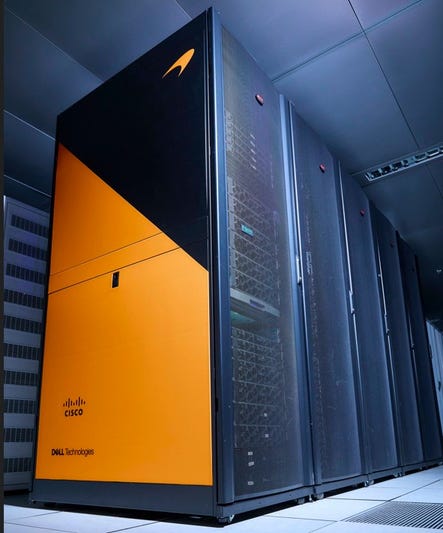Cisco Fuels McLaren F1 Team’s Pursuit of the World ChampionshipCisco Fuels McLaren F1 Team’s Pursuit of the World Championship
The McLaren team leverages a variety of Cisco solutions, including gear for its high-bandwidth wireless and wired network, to pursue a World Championship.
November 22, 2024

Formula One (F1) recently held its annual Grand Prix race in Austin, Texas. I attended the event, was given a “behind-the-scenes” tour of the McLaren F1 Team’s garage, and spoke with Dan Keyworth, Director of Business Technology at McLaren Racing, and Cisco executives responsible for the partnership. The media tour gave us a first-hand look at the complexity of getting the cars and drivers ready for a race and the role of data and connectivity.
While Cisco has many relationships with various leagues and sports teams, the McLaren one is the most complete partnership as the organization leverages Cisco's networking and security technology and Webex, as well as the recently acquired Splunk observability platform. The relationship with Cisco is multi-faceted, and Splunk was the first leg, although it long predated the acquisition by Cisco. The partnership with Splunk started about five years ago. In 2019, the McLaren team met with Splunk as the software engineers led the analysis of suspension data in Splunk. The McLaren team chose Splunk because it handles low latency and high-volume data.

(Credit: McLaren)
Roots of the McLaren – Cisco Relationship
The partnership with Cisco began when McLaren was initially a customer of the company, which eventually transformed into a partnership. Keyworth discussed the difference between being a partner and a customer: “As a customer, a partnership made absolute sense, and the relationship has helped accelerate our ability to transform at pace and keep up with the competition.” Since then, Cisco has acquired Splunk, which should create a step function in value for McLaren.
What’s interesting about the relationship between F1 teams and the technology vendors is that, unlike some other sports, teams can’t be given equipment for free. Keyworth explained, “Any technology products we use count against the hard $140M expenditure cap for the season, so we choose all of our technology partners as they are the best in their respective areas.”
As one would expect in an environment as competitive as F1, the McLaren team has many custom applications and ways to monitor performance. During the pandemic, there was a focus on eSports, and the team used Splunk to analyze the gaming data. The analysis enabled McLaren to win the eSports championship. More importantly, the lessons learned from analyzing the gaming rig information could be implemented with the physical cars.
The pandemic also required rethinking how fans could engage with the McLaren team. During the pandemic, a TV studio was built with Webex to create a virtual guest experience. This would enable remote fans to see into the garage and experience race day action, much like when we visited the F1 Paddock. The TV studio was also used for pre- and post-game shows, enabling that experience to be shared with people at home.

(Credit: McLaren)
McLaren Revamps After the Pandemic
Post-pandemic, the McLaren team transformed the McLaren Technology Centre (MTC) in Woking, UK, from a traditional office space to one optimized for collaboration. All the rooms were equipped with Cisco devices as they were the only ones able to handle Microsoft Teams, Zoom, Google Meet, and Webex meetings with a single touch and without requiring a reboot. While McLaren has standardized on Webex, many other partners it works with use different platforms, so the device flexibility enables McLaren to work with multiple platforms.
The third piece of the technology was an upgrade to the network. F1 cars create a massive amount of information. Each vehicle has over 300 sensors, creating about 1.5TB of data per race. This information must be sent over the network to the local data center in the Paddock at the track and then also with the MTC in the UK. Keyworth explained the older network had reached its capacity and needed help to keep up with the demands of modern racing. Also, traffic patterns had changed with more processing at the edge.
The new network had to be as high-bandwidth as possible, including wireless, as the McLaren F1 Team wanted to push the edge as far as it could go, meaning the car. A 100 Gig-E network was deployed in the core and across the building to the edge. I asked what the most noticeable difference was with the upgraded network and was told that, outside of speed, it was the reliability and resiliency of the network.
Keyworth explained that there were many moments when the network was noticeably reaching its limits. For example, on Friday afternoons, when everyone was making final preparations for a race, connected machine tools were running, and other activities were taking place. To add to the problem, McLaren used advanced analytic systems like wind tunnels and simulators, generating a tremendous amount of multi-cast information that required a highly available network.
Looking ahead, McLaren is looking forward to adopting two aspects of advanced technology. The first is AI-based automation for running the network. The network operations team is continually tweaking the network to adapt to different conditions or requirements. The ability to automate functions would reduce the human labor required to run the network. Given the hard cap of $140M to run the operations for the year, any reduction of people costs could be money that’s reallocated toward equipment, research, or other functions that could more directly impact winning or losing on the track.
The other technology that McLaren believes will be beneficial is Cisco Hypershield. Earlier this year, Cisco announced its most recent security innovation for those unfamiliar with the product. An easy way to think about Hypershield is it takes firewall capabilities, embeds them in the network, and distributes them everywhere, creating a firewall “fabric” that spans the end-to-end network. Given McLaren's distributed data, Hypershield would enable security protection everywhere, from the car to the compute resources in the Paddock and back to the MTC. The product is currently in beta, but McLaren is keeping an eye on it as the team recognizes the need to rethink security in the AI era, where data is scattered everywhere.
For the race, the McLaren F1 Team finished 4th and 5th in Austin, a respectable finish in the duo of Lando Norris and Oscar Piastri. This adds to the McLaren team's successful season, with both drivers in the top four overall points.
F1 is one of the most data-intensive businesses today, and speed is everything. Understanding how McLaren views the role of modernized infrastructure in its quest to continually find new ways to gain an advantage over the competition is a good lesson for all IT leaders. All businesses are data-driven, and the key to sustainable market leadership is continually finding insights in the data to transform the organization. As McLaren knows, speed matters, but that's now a universal truth across all businesses.
Zeus Kerravala is the founder and principal analyst with ZK Research.
Read his other Network Computing articles here.
Read more about:
CiscoAbout the Author
You May Also Like




